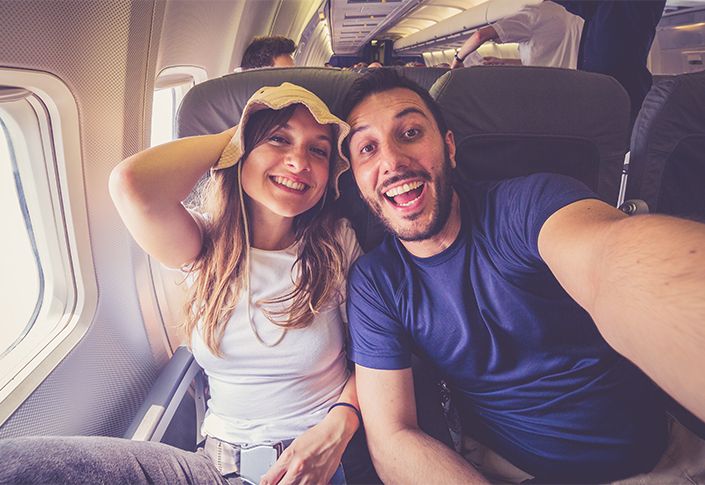Where travel agents earn, learn and save!
News / Is aircraft air really safe and clean?
Plane is probably the last place you’ll be likely to get sick

June 8 - Flying on a plane might seem daunting right now. After all, being sealed in a tube with hundreds of other people for several hours sounds like the perfect place to incubate bugs. But you might be surprised to know that a plane is probably the last place you’ll be likely to get sick. Here’s why.
Aircraft air is not recirculated
Contrary to popular belief, the air in an aircraft cabin does not just get recycled ad infinitum. The air is sucked out of the cabin, mixed with fresh air from outside the plane on a 50:50 basis, and redelivered to the cabin.This continuous renewal of air means the cabin air is completely replaced around 20 – 30 times every hour. To compare that to a situation on the ground, it’s like standing in a bus shelter on the top of a very windy hill.
Aircraft air is as clean as an operating theatre
Cabin air is filtered through the very same devices that are used in hospital operating theaters. Called HEPA filters, these remove between 85% and 99.9% of bacteria, viruses and other contaminants, depending on their efficiency.Given the current situation, many airlines are upgrading their HEPA filters to ‘hospital-grade.’ This is the highest efficiency rating available and filters out 99.995% of small particles. As the industry’s global trade organization, the International Air Transport Association says,
“The risk of catching an infection on an aircraft is typically lower than in a shopping center or office environment.”
Cabin air flow goes up and down, not side to side
The air from the cabin is drawn out by vents near your feet. You’ve probably never noticed them, but take a look next time you fly.After it has been sucked out, mixed with clean, fresh air and sent through those hospital-grade filters, it is delivered back into the cabin through vents above your head. You’ll have noticed the twisty vents that you can turn on to deliver a blast of fresh air; even if you don’t open these, there are other vents behind the luggage storage which keep the air circulating.
This means that the air flow is from top to bottom. It creates a curtain of air flow, meaning that air is not mixed between rows, unlike in an office where air tends to go around and around in circles. This makes it much safer, and much more difficult to transmit bugs around the cabin.
But people have become ill after flying?
We all have a friend, relative, or even personal experience of flying home from holiday and not feeling too good afterward. However, the truth is that it was very unlikely to be the time spent on the plane that caused us to feel unwell.Considering how clean and safe aircraft cabin air is, why is it some people think they’ve become sick from their travels? There are a few explanations here:
• Other parts of your journey are higher risk: While aircraft cabin air is clean and safe, the same can’t always be said for other environments. Traveling to the airport on a train or bus, moving around a congested terminal and otherwise being in close proximity to other people carries a high risk of transmission
• Fatigue lowers your immune system: Being tired makes you more susceptible to catching a bug. Flying across time zones, not sleeping well before the flight, or traveling on a red-eye can make you more likely to pick something up in the airport, on the bus, or at some other point in your journey
• Stress, nicotine and alcohol do the same: Feeling anxious about your journey or having a big night out at the end of your holiday can also make your immune system less able to fight off illness
• Illnesses incubate for several days: Most common illnesses have lead in times of several days between becoming infected and showing symptoms. For example, the common cold incubates for two to five days, while flu takes one to three days. Viral infections like measles and chickenpox can take up to three weeks. This means you may have contracted the bug on your holiday but still felt well until after your flight home
The only part of traveling by plane that does put you at more risk is the arid air. At altitude, there is little to no humidity in the air being brought into the cabin. As a result, cabin air is usually less than 20% humidity.
Modern long-haul planes like the Airbus A350 and 787 Dreamliner maintain higher humidity levels, but most others don’t. As a result, you can end up feeling dry, grotty and be more susceptible to infection
For this reason, it’s important to stay hydrated through all parts of your journey. Drink plenty of water, use eye drops and nasal spray to soothe, and moisturize to protect your skin.
The biggest risk is other passengers
Sitting on an aircraft will not cause you to become sick. The air is cleaner than in most environments, and airlines are adopting deep cleaning procedures between every turn to ensure the cabin is disinfected between trips.However, if someone a couple of rows behind is harboring a virus and they cough or sneeze, there is still a chance you could get sick. For this reason, many airlines are mandating the wearing of a mask in flight, as this can significantly reduce this risk.
Wearing a mask yourself does not entirely remove the risk of catching a bug, but it does provide significant protection for others if you happen to be incubating something. If you want others to keep you safe on the plane, set the example by wearing your own mask for the duration of your flight.
More Travel News:
Dreams Vista Cancun Golf & Spa Resort has opened its doors!
Exodus Travels: Travel Safety Charter
G Adventures: A conversation on Race in Travel
As tourism starts, our responsibilities remain











